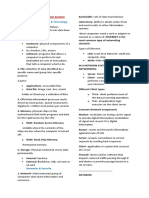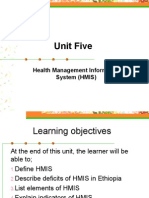0% found this document useful (0 votes)
9 views3 pagesChapter 1
Health Information Systems (HIS) are crucial for collecting, managing, and transmitting health-related data to improve decision-making and enhance healthcare quality. The document outlines the historical development of HIS, from paper-based systems to modern technologies like cloud computing and AI, and highlights the components and specific systems in Ethiopia, such as HMIS and DHIS2. Challenges include data inaccuracies and limited infrastructure, but ongoing improvements focus on digital health strategies and personnel training.
Uploaded by
mulukenb21Copyright
© © All Rights Reserved
We take content rights seriously. If you suspect this is your content, claim it here.
Available Formats
Download as DOCX, PDF, TXT or read online on Scribd
0% found this document useful (0 votes)
9 views3 pagesChapter 1
Health Information Systems (HIS) are crucial for collecting, managing, and transmitting health-related data to improve decision-making and enhance healthcare quality. The document outlines the historical development of HIS, from paper-based systems to modern technologies like cloud computing and AI, and highlights the components and specific systems in Ethiopia, such as HMIS and DHIS2. Challenges include data inaccuracies and limited infrastructure, but ongoing improvements focus on digital health strategies and personnel training.
Uploaded by
mulukenb21Copyright
© © All Rights Reserved
We take content rights seriously. If you suspect this is your content, claim it here.
Available Formats
Download as DOCX, PDF, TXT or read online on Scribd
/ 3























































































